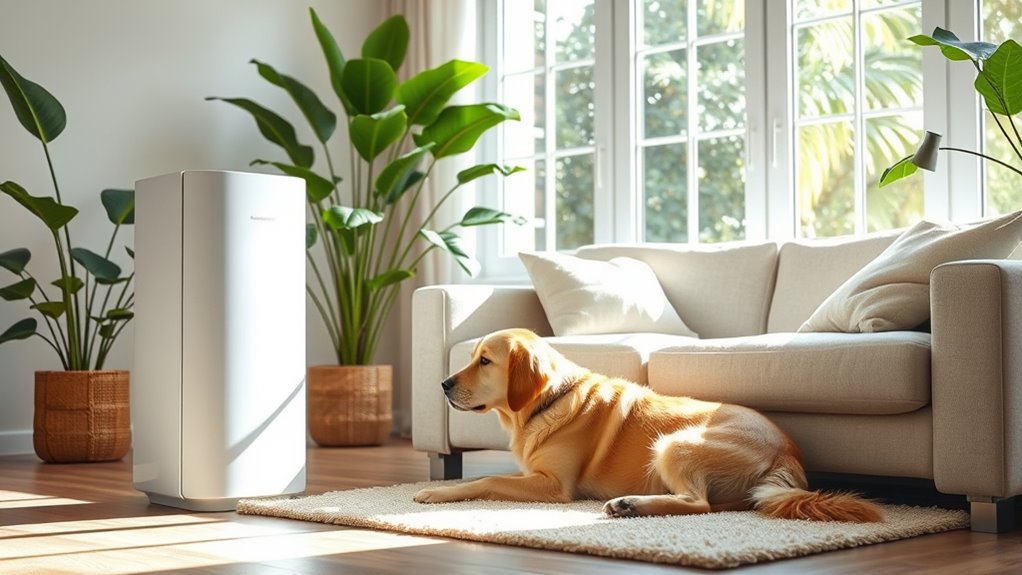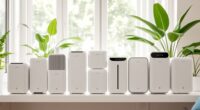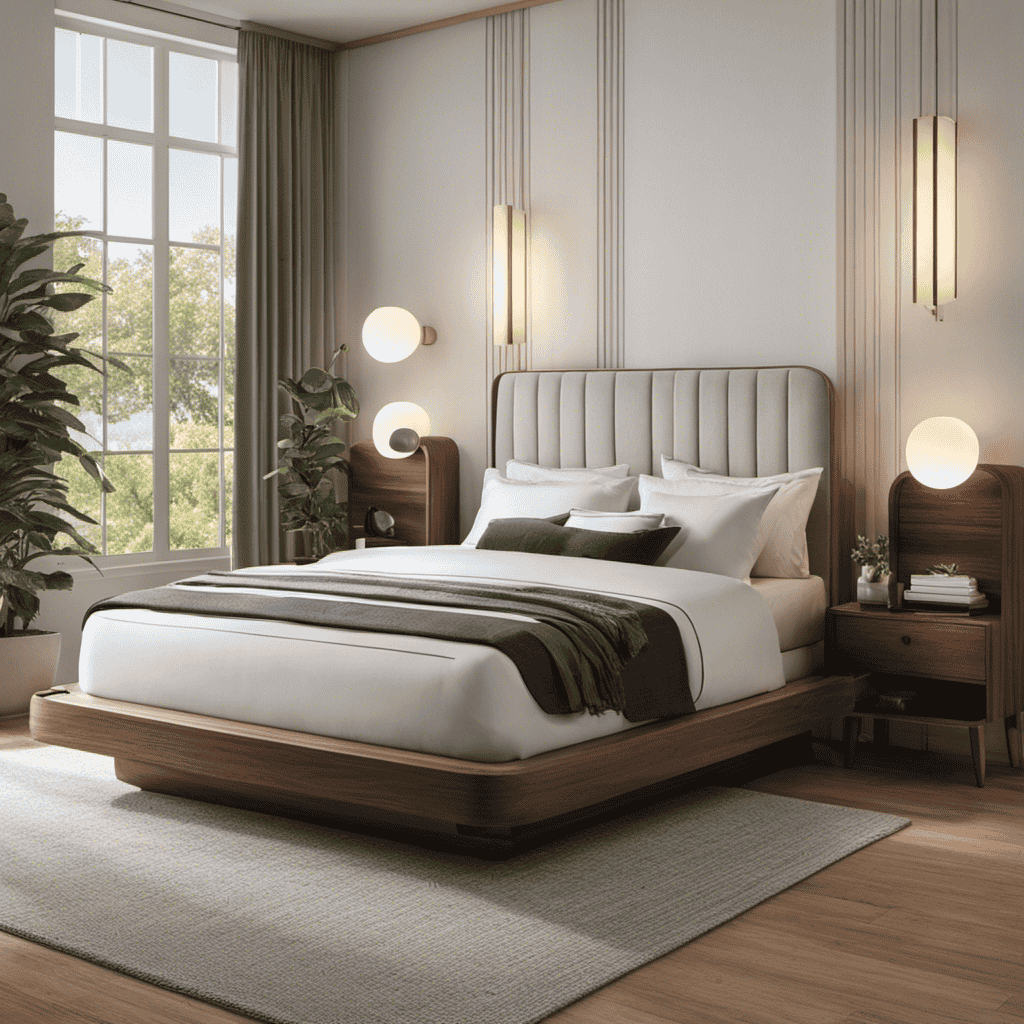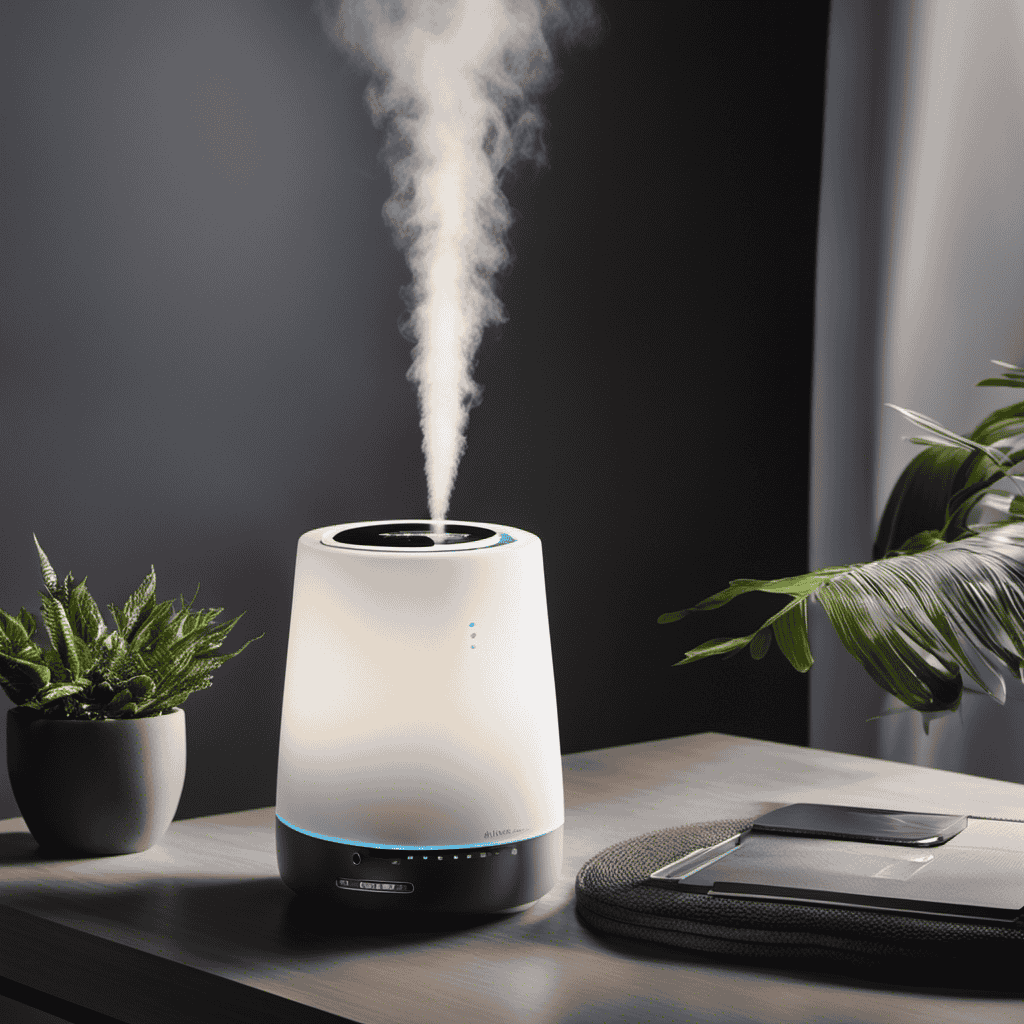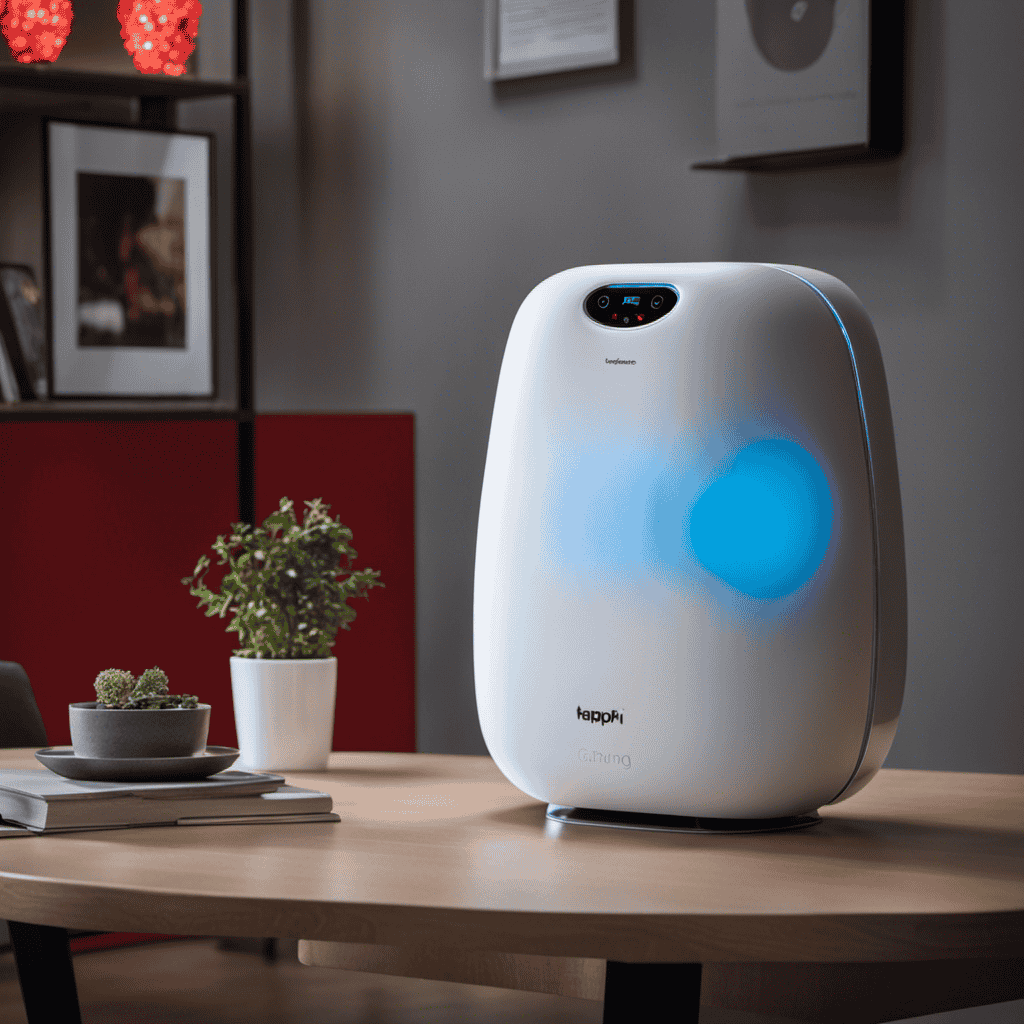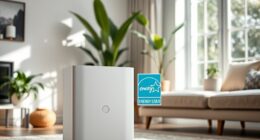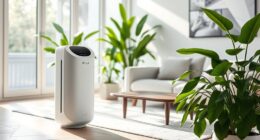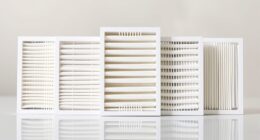Air purifiers can be safe for your pets if you choose models featuring HEPA filters and activated carbon to effectively remove dander, odors, and harmful particles. Make sure they operate quietly, are properly maintained, and are placed away from pet beds or feeding areas. Avoid units that emit ozone or toxic fumes. Staying vigilant for any signs of discomfort helps ensure your pets benefit from cleaner air. To learn more about safe and effective options, continue exploring the details.
Key Takeaways
- High-quality HEPA and activated carbon filters are safe for pets when properly maintained and free from harmful chemicals.
- Choose quiet, low-decibel models to prevent stress and behavioral issues in pets.
- Regular filter replacement and avoiding ozone or ionizer units prevent the emission of harmful substances.
- Proper placement away from pet beds, feeding areas, and litter boxes ensures safety and optimal air quality.
- Monitoring pets for signs of irritation or stress helps ensure air purifiers are safe and beneficial for their health.
Understanding Different Types of Air Purifiers
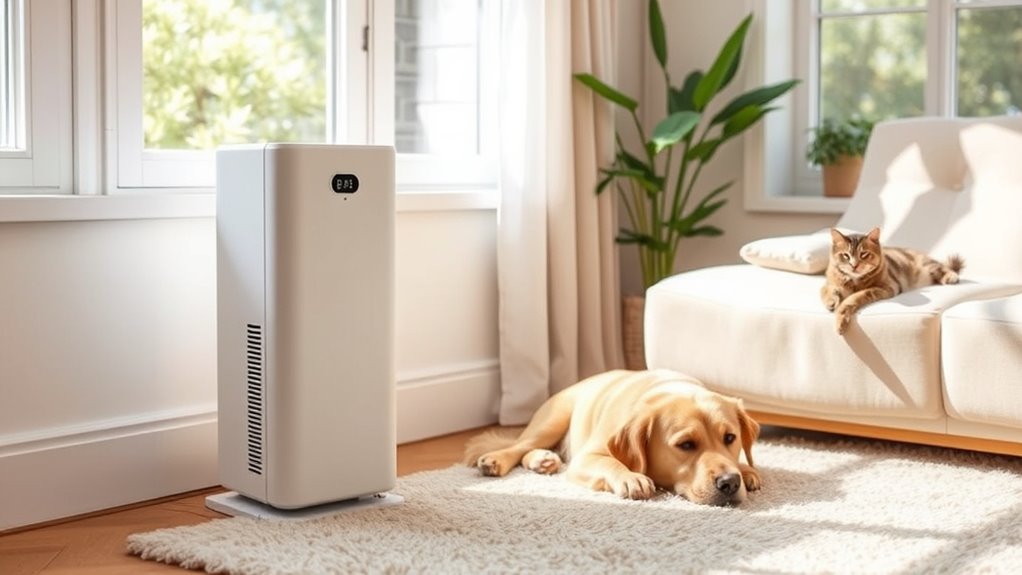
Have you ever wondered how different air purifiers work to improve indoor air quality? Understanding the various types helps you choose the right one and maintain it properly. HEPA purifiers are popular for removing airborne particles like dust and pet dander, but they require regular air purifier maintenance to stay effective. Activated carbon filters excel at absorbing odors and gases, making them ideal for households with pets. UV purifiers use ultraviolet light to kill bacteria and viruses, though they often come with specific air purifier warranties to cover bulb replacements or repairs. Knowing these differences ensures you select a device suited to your needs and keeps it functioning at its best, so your indoor environment stays fresh and safe for your pets. Additionally, considering the technology used in filters can help you understand how each type improves air quality more effectively. Staying informed about air purifier advancements can also guide you toward the most efficient and safe options for your household. Regularly checking filter replacement schedules ensures that your air purifier continues to operate at peak performance, further safeguarding your pets’ health.
Potential Risks of Air Purifiers to Pets
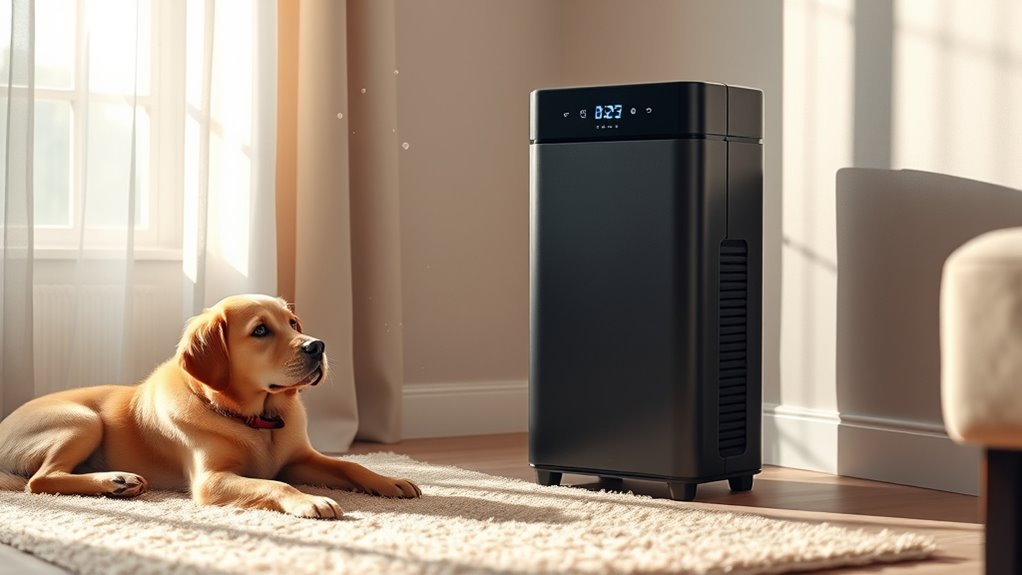
While air purifiers can considerably improve indoor air quality, they also pose potential risks to your pets if not used carefully. High noise levels from certain models can stress or scare your pets, leading to anxiety or avoidance. Additionally, improper filter replacement frequency might cause the purifier to emit allergens or mold, which can harm your furry friends. Be cautious of the following risks:
- Excessive noise causing pet stress
- Allergens from neglected filters
- Toxic fumes from cheap or faulty units
- Pets ingesting or chewing on the device
- Disruption of natural pet behaviors
- Regular maintenance and filter checks are essential to prevent these issues air quality monitoring and ensure your pets remain safe and comfortable around air purifiers. Proper maintenance practices can significantly reduce these hazards and ensure your pets remain safe and comfortable around air purifiers. Regularly monitoring air quality indicators can help detect issues early and prevent potential problems. Furthermore, choosing models with quiet operation features can make a substantial difference in maintaining a peaceful environment for your pets.
To keep your pets safe, monitor the noise levels, follow the recommended filter replacement schedule, and choose quiet, pet-friendly models. This ensures your air purifier benefits your home without unintended harm to your pets. Understanding credit card terms and staying informed about related issues can help you better manage your household environment.
Features to Look for in Pet-Friendly Air Purifiers
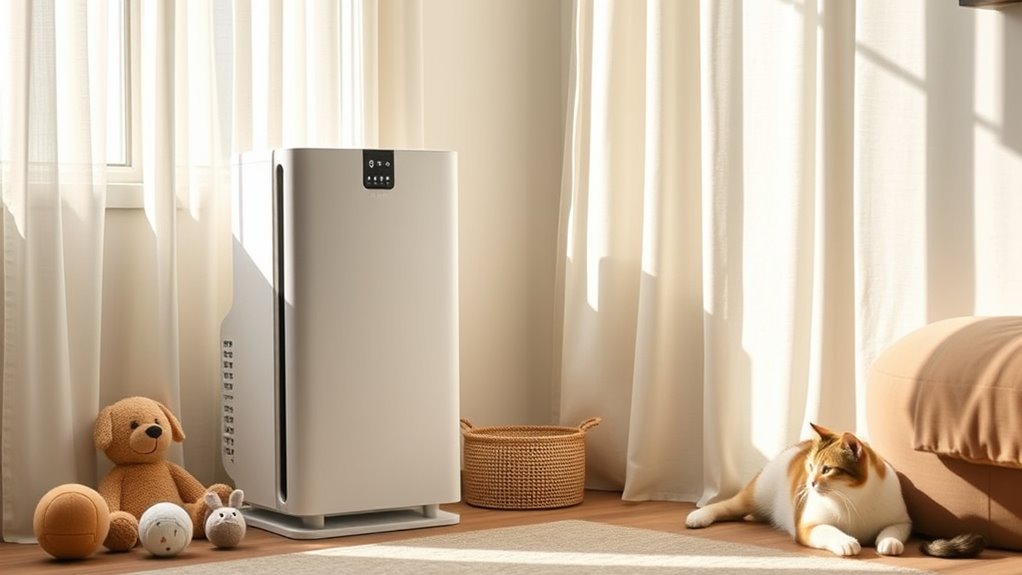
When choosing a pet-friendly air purifier, you’ll want to focus on safe filter options that won’t release harmful substances. Quiet operation is also essential to prevent stressing your pets during use. By prioritizing these features, you can guarantee cleaner air without compromising your pet’s well-being. Additionally, understanding small mistakes related to air quality can help you make better choices for your pet’s environment. Ensuring your air purifier includes GMC tuning features that optimize air flow can further enhance the effectiveness of the device. Proper placement and regular maintenance are crucial to avoid issues like ineffective purification, which can undermine the benefits of your air purifier. Being aware of pinball machine weights can also help you select a device that fits well within your space and is easy to manage. Incorporating dog names that reflect your pet’s personality can also create a more comforting environment for your furry friend.
Safe Filter Types
Choosing the right filter type is essential to guarantee your air purifier is safe for pets. Look for filters that effectively trap allergens and odors without releasing harmful substances. HEPA filters are excellent because they capture 99.97% of particles, including pet dander, pollen, and dust mites, making them ideal for pet households. Activated carbon filters absorb pet odors, fumes, and VOCs, keeping your home smelling fresh. Ensure the filter is free from unnecessary chemicals or fragrances that could irritate your pet’s respiratory system. Safe filter types are crucial for maintaining a healthy environment for your furry friends. Incorporating filters made from non-toxic, pet-safe materials further minimizes potential health risks. Consider these features: – HEPA filtration for allergens – Activated carbon for odors – Non-toxic, pet-safe materials – Replaceable filters for easy maintenance – No added fragrances or chemicals. Additionally, choosing filters that are free from synthetic chemicals helps ensure the air remains safe for sensitive pet respiratory systems. It is also beneficial to select filters with certifications or testing that verify their safety for use around pets. When selecting an air purifier, look for those with independent safety testing, which can provide added assurance of their suitability for pet environments.
Quiet Operation Features
A pet-friendly air purifier should operate quietly to avoid disturbing both your pets and your daily activities. Low noise levels are essential, especially if your pets are sensitive or sleep nearby. Look for models with a “quiet mode” or low decibel settings, typically around 20-30 dB, to guarantee minimal disruption. Excessive noise can cause sleep disturbance for your pets, leading to stress or anxiety. Choose an air purifier with a reputation for quiet operation, so it runs smoothly in the background without drawing attention. By prioritizing quiet features, you create a peaceful environment that keeps your pets comfortable while maintaining clean indoor air. Regularly checking for projector issues can also help maintain a peaceful environment by preventing unexpected disturbances. Additionally, selecting a model with AI-driven solutions can enhance overall performance and adapt to your home’s needs.
Proper Placement and Usage of Air Purifiers Near Pets
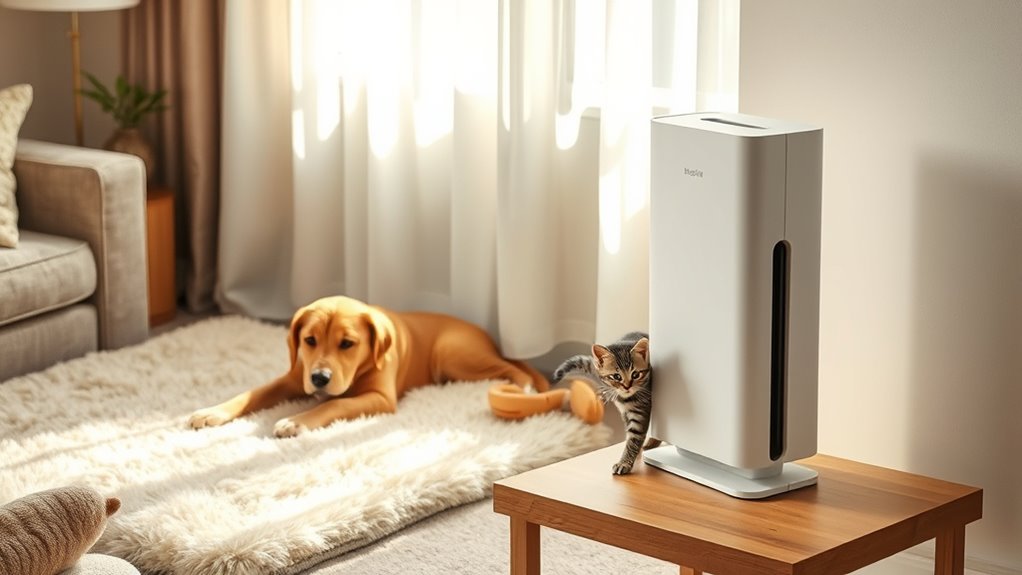
To guarantee your air purifier benefits both you and your pets, consider the best placement strategies, like keeping it at a safe height and away from pet beds. Choose safe, pet-friendly models that won’t harm or disturb your furry friends. Keep an eye on how your pets react, adjusting the setup if needed to maintain a comfortable environment. Additionally, selecting a model with HEPA filters can help effectively capture pet dander and allergens, improving air quality for everyone. Proper air circulation can prevent the buildup of pollutants, creating a healthier space for your household. Being aware of pet behaviors around air purifiers can help prevent accidents and ensure safe operation for your household. Understanding air quality factors that affect pets can further optimize your setup for their safety and comfort.
Optimal Placement Strategies
Proper placement of air purifiers is crucial for maximizing their effectiveness around pets. To guarantee ideal air purifier placement and pet safe positioning, consider these tips:
- Keep the unit at least a few feet above ground to avoid pet interference
- Place it in areas where your pet spends most of their time
- Avoid placing it near litter boxes or pet bedding to prevent contamination
- Make sure it’s not directly facing pet feeding or watering spots
- Position it away from open windows or vents that could redirect dust or pollutants
- Be mindful of bank and finance operating hours to plan maintenance or visits accordingly.
- Additionally, selecting models with HEPA filters can help ensure that airborne allergens and pet dander are effectively captured, promoting a healthier environment for your pets. Proper air circulation in your home can also enhance the purifier’s performance and ensure consistent air quality.
- Ensuring proper filter replacement is essential for maintaining optimal air purifier performance and safeguarding your pets’ health. Regularly monitoring filter status aligns with AI-supported maintenance recommendations to optimize device longevity and efficiency.
Safe Air Purifier Types
Choosing the right air purifier types is essential for safely improving indoor air quality around pets. Look for models with HEPA filters, as they effectively trap pet allergens and reduce pet allergies. Avoid air purifiers with ozone generators or ionizers, which can produce harmful ozone levels harmful to both pets and humans. Proper placement is key; keep the device away from pet beds and high-traffic areas to prevent disturbance and guarantee optimal filtration. Regular air purifier maintenance, such as changing filters as recommended, keeps the unit functioning efficiently and prevents the buildup of dust and pet dander. By selecting safe air purifier types and maintaining them properly, you can improve air quality without risking your pet’s health or exposing them to unnecessary hazards.
Monitoring Pet Reactions
When placing your air purifier near your pets, it’s important to observe how they react to its presence and operation. Watch for changes in pet behavior, such as hiding, excessive scratching, or unusual vocalizations. Keeping an eye on allergy symptoms can also help you gauge if placement is effective or causing stress.
Consider these tips:
- Place the air purifier in a quiet, accessible spot.
- Ensure it’s not blowing directly on your pet.
- Monitor for signs of discomfort or anxiety.
- Check if your pet shows reduced allergy symptoms over time.
- Adjust positioning if pets seem distressed or overly alert.
Monitoring reactions helps you find the right balance, keeping your pet comfortable while maximizing air purifier benefits.
Signs of Adverse Reactions in Pets Using Air Purifiers
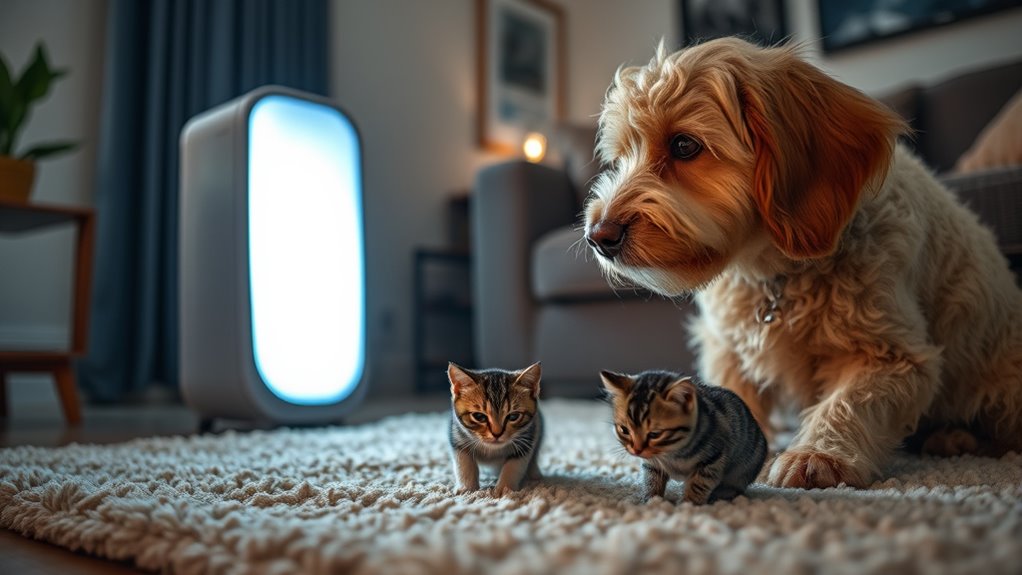
Pets can sometimes show signs of discomfort or adverse reactions after an air purifier is introduced into their environment. Watch for pet allergy symptoms like sneezing, itching, or watery eyes. Respiratory distress, including rapid breathing or coughing, is also a red flag. These reactions may indicate that the purifier’s filters or emitted particles are irritating your pet’s sensitive airways.
| Symptom | Possible Cause |
|---|---|
| Sneezing or itching | Allergens or irritants in the air |
| Coughing or wheezing | Respiratory distress from pollutants |
| Watery eyes | Irritation from airborne particles |
| Lethargy or reluctance to move | Discomfort or breathing difficulty |
Stay alert and consult your vet if you notice these signs to ensure your pet’s safety.
Tips for Maintaining Safe Indoor Air Quality for Pets
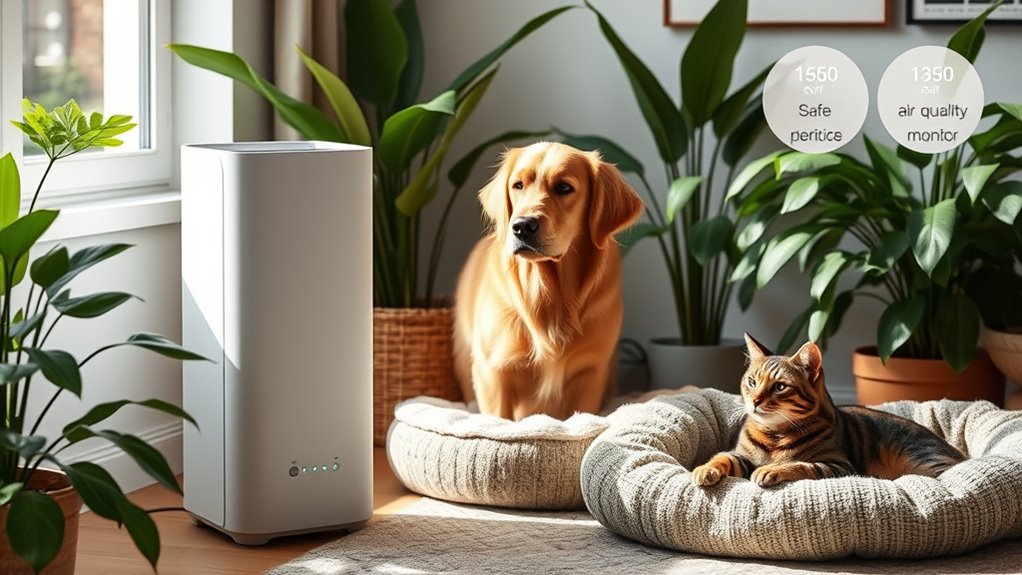
To maintain safe indoor air quality for your pets, it’s essential to regularly clean and replace air purifier filters according to the manufacturer’s instructions. Proper air purifier maintenance helps reduce pet allergens and prevents buildup of dust and dander. Keep your space well-ventilated by opening windows when possible, and avoid smoking indoors. Use hypoallergenic cleaning products to minimize airborne irritants. Regularly vacuum carpets and furniture to reduce pet hair and dander. Monitor your pet’s reactions for signs of allergies or respiratory issues.
Here are some tips:
- Replace filters as recommended to prevent mold and bacteria growth
- Clean air vents and ducts regularly
- Keep pets out of bedrooms during air purifier operation
- Avoid using harsh cleaning chemicals
- Schedule annual professional air quality assessments
Frequently Asked Questions
Can Air Purifiers Eliminate Pet Dander Effectively?
An air purifier can effectively eliminate pet dander if you maintain it properly. Regular air purifier maintenance, such as changing filters as recommended, guarantees it captures pet allergens efficiently. This can lead to significant pet allergy relief, making your environment more comfortable. Keep in mind that choosing a purifier with a HEPA filter maximizes dander removal, so you’ll breathe easier and reduce allergy symptoms for both you and your pets.
Are HEPA Filters Safe for Pets to Breathe?
You wonder if HEPA filters are safe for your pets to breathe. HEPA filtration is designed to trap tiny particles, including pet dander, dust, and allergens, making it safe for your pets’ respiratory health. Pet safety is prioritized because HEPA filters don’t emit harmful chemicals or ozone. As long as you choose a certified unit and maintain it properly, you help create a cleaner, healthier environment where your pets can breathe freely and comfortably.
Do Ozone Generators Pose Health Risks to Pets?
You should know that ozone generators can pose ozone health risks to pets. They produce ozone, which can irritate your pet’s respiratory system and worsen existing conditions. While some believe ozone generators improve air quality, their use can compromise pet safety. To protect your furry friends, avoid ozone generators in enclosed spaces and opt for safer air purification options that don’t emit harmful ozone levels, ensuring your pet’s health stays protected.
How Often Should I Replace Filters Around Pets?
Imagine your home as a revitalizing gust—clean and vibrant. To keep it that way, you need to mind the filter lifespan and replacement frequency. Typically, check filters every 1-3 months, especially with pets that shed or produce dander. Replace filters promptly when they look dirty or after the recommended interval. This ensures your air purifier continues to safeguard your pets’ health and maintains excellent indoor air quality.
Can Air Purifiers Help With Pet Allergy Symptoms?
Air purifiers can help with pet allergy symptoms by removing dander, hair, and other allergens from your home’s air. However, consider the air purifier noise, as loud models might disturb your pet’s comfort. Choose a quiet, efficient unit to guarantee it improves air quality without stressing your pet. Regular filter changes maximize effectiveness, helping your pet breathe easier and stay comfortable in a cleaner environment.
Conclusion
Knowing how to choose and use air purifiers safely can substantially improve your pet’s indoor environment. Did you know that indoor air can be up to five times more polluted than outdoor air? By selecting pet-friendly models, placing them correctly, and monitoring your pets’ reactions, you can guarantee cleaner air without risking their health. Keep these tips in mind, and enjoy a safer, healthier space for your furry friends.
